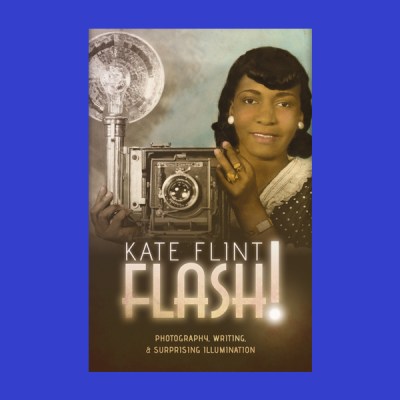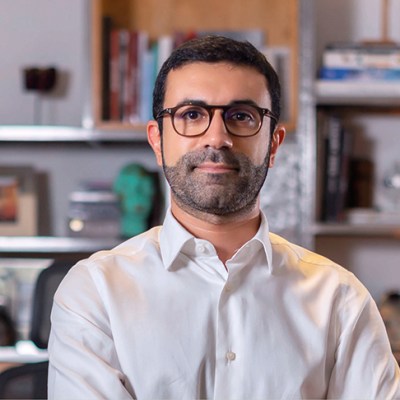From the July/August 2022 issue of Apollo. Preview and subscribe here.
In the first retrospective exhibition devoted to the Malagasy photographer Ramily (1939–2017), there are many portraits of the man himself. He has a look; his thick hair swept back like a mid-century movie star, one lock falling forwards. In the black-and-white photos, he wears a casual shirt and leans against things – a car bonnet or a wall – looking debonair and confident. There’s one particular photo that stands out in the show. Ramily took a series of images of the photographic studios of Madagascar’s capital city Antananarivo and the people that ran them. They are all men (apart from one woman, Eda, who looks serious – almost nervous – as she stands just outside the threshold of her establishment). Ramily is pictured leaning against the front door of his studio Techni-Photo, the studio he founded and which still exists decades later in the same a suburb. By documenting this new thriving industry with these photographs, Ramily was signalling his place at the head of it.
Émile Rakotondrazaka, known more commonly as Ramily, was born in 1939, when Madagascar was a French colony. Nationalist movements were violently repressed; some say up to 100,000 residents were killed during an uprising against the French in 1947. The oldest of 10 siblings, Ramily was sent in 1949 to finish his education at the house of a pastor. He became the assistant of his host’s eldest son who specialised in passport photography, and so began a career that would span decades of political and cultural change. He was 21 years old when Madagascar declared independence. In 1975 a coup led to a 30-year dictatorship and ‘malgachisation’, a political movement that tried to foreground Malagasy culture in opposition to French influence.
Autoportrait 3 (n.d.), Ramily. Hakanto Contemporary, Madagascar. Photo: courtesy Hakanto Contemporary, Madagascar

It is an interesting exhibition choice for Hakanto Contemporary, an arts centre in Antananarivo founded in 2020 and dedicated to fostering the local contemporary art scene. It is financed by the energy entrepreneur and art collector Hasnaine Yavarhoussen (who in 2020 was named in Apollo’s ‘40 under 40 Africa’ list), but operates under the direction of Joël Andrianomearisoa, an artist who represented Madagascar and organised the country’s first pavilion at the Venice Biennale in 2019.
Just as Ramily documented other photographers, Andrianomearisoa brings attention to other artists, past and present. The first show was a collective exhibit of young Malagasy artists. Now Hakanto explores the country’s artistic heritage through one of its most famous photographers with its second exhibition ‘Ramily Ilay Nanao Ny Maraina’ (Ramily who revealed the day). The photographs are accompanied by texts by a Malagasy academic Ludonie Velontrasina. Ramily’s work offers a different view of the country, she says. ‘He doesn’t photograph in order to show misery.’
Arbres, brise, vent – Horombe, Ihosy (1973), Ramily. Hakanto Contemporary, Madagascar. Photo: courtesy Hakanto Contemporary, Madagascar

Ramily was mainly a commercial photographer, working from his studio and travelling throughout the island to take photos of thousands of Madagascans at weddings, baptisms and funerals. In some ways his story and significance follow a familiar narrative in African photography: Ramily was a pioneer because he captured the country as it wanted to be seen, just as it was trying to figure out a national identity post-independence. He took photographs of modern-looking people at sporting events and business conferences; he photographed images for the new passports that were being issued, but also captured icons of the day. There are some beautiful, almost abstract, images of a couple walking across fields: the pop duo Bessa and Lola, the Malagasy answer to Sonny and Cher, from whose lyrics the exhibition takes its title.
At the start of the exhibition, there is an empty chair with a backdrop from Ramily’s studio. Instead of the checked patterns or American pop culture motifs we’re used to seeing in, for example, West African studio photography, there is a painted scene of a lush, verdant landscape. It is almost a corollary to Ramily’s photographs of Madagascar’s varied landscapes. (And it is these that really seem to inspire Andrianomearisoa, whose own work often plays with patterns, textures and lines that cut his canvases into two.)
Andrianomearisoa also has a look: slight and energetic, he dresses in black and white and wears round thick-rimmed glasses. He leads me around the exhibition, pointing out the sharp relief of the plains or the rocks against the sky in the photographs. There is one nearly surreal image, in which trees line the highest edge of the plain, almost like a herd of wildebeast trudging across the horizon. Andrianomearisoa points out the contrast between air and earth that characterises the island. ‘We are all dying for this view,’ Andrianomearisoa says. ‘I think it is coming from the idea that we are on an island, so we’re all trying to figure out what’s happening beyond the horizon.’
Ramily was also a master technician – a ‘chemical magician’, says Andrianomearisoa. His dark room has been transposed to
Hakanto’s space. All of the images featured in the exhibition were printed by Ramily himself. They were found in his neatly organised archives and selected by his son, Hery Rakotondrazaka, a photojournalist who still runs the studio. On the wall of the studio itself are still the shadow outlines of frames which Ramily crafted and sprayed. When I visit, I am greeted by the secretary who used to work for Ramily. Rakotondrazaka, softly spoken yet fiercely proud of his father’s legacy, shows me around while also managing to look after clients. One of the central rooms of the studio has been converted by a nephew into a cyber cafe.
With the advent of social media, we are all curating our own images now but the selfie hasn’t destroyed the magic of sitting for a portrait. A young man brushes his hair in front of the mirror then sits slightly nervously for his photograph to be taken. His girlfriend waits patiently for him, holding his jar of hair pomade. Behind, a queue of customers wait their turn for the digital camera to capture their likenesses.
From the July/August 2022 issue of Apollo. Preview and subscribe here.



